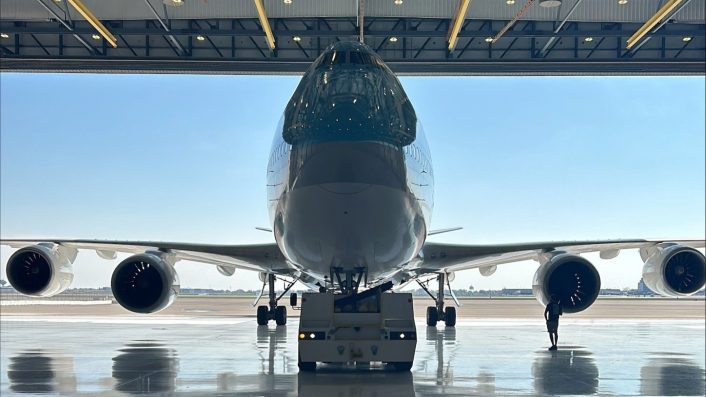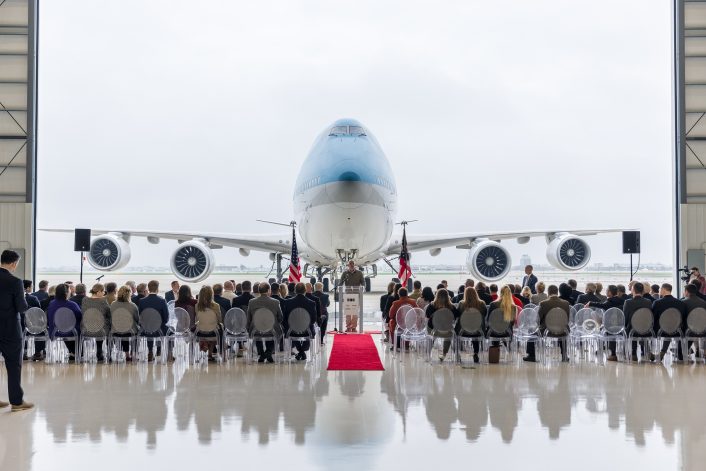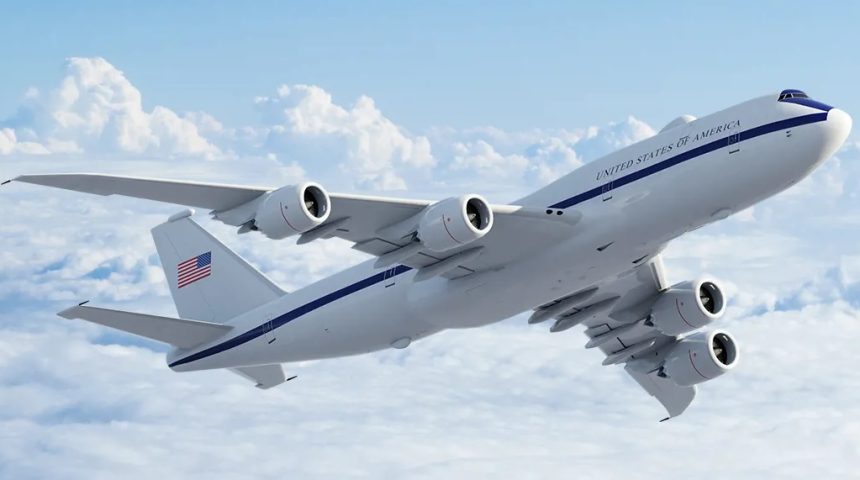The second Boeing 747-8 arrived in Dayton after a 12-hour flight from Seoul and will be converted to a ‘Doomsday’ aircraft at SNC’s Aviation Innovation and Technology Center.
Sierra Nevada Corporation has received the second Boeing 747-8 to be converted in the future Survivable Airborne Operations Center (SAOC) at its Aviation Innovation and Technology Center (AITC) in Dayton, Ohio. The aircraft arrived there on Oct. 30, 2024, after a 12-hour flight from Seoul, where it was previously located.
SNC acquired earlier this year five B747-8s from Korean Air for approximately $674 million, as the airline is phasing out older aircraft and introducing newer generation models. The aircraft are scheduled to be delivered by September 2025, with the first one already arrived in Dayton on Jun. 4, 2024.
The 2nd of 5 Korean Airlines Boeing 747-8B5 (HL7631) was delivered today to Sierra Nevada Corporation in Dayton, Ohio and will be modified into as the E-4C SAOC to replace the 4 Boeing E-4Bs currently in service.
Audio via @liveatc https://t.co/khviOSgmeW pic.twitter.com/pDUUA56WXf
— Thenewarea51 (@thenewarea51) October 30, 2024
The new “Doomsday” aircraft, meanwhile, has now also received its official designation by the U.S. Air Force. In fact, the Test & Evaluation Oversight List of the Director, Operational Test & Evaluation, released on Aug. 30, mentions the new aircraft as the “Survivable Airborne Operations Center E-4C.”
Under the U.S. Air Force’s SAOC contract award, SNC will modernize and deliver a replacement for the current fleet of E-4B Nightwatch aircraft. This highly specialized aircraft serves as an airborne command center for the President, Secretary of Defense and Chairs of the Joint Chiefs of Staff to ensure continued critical command, control and communication (C3) during national emergencies.
Exciting news! The second 747-8i has arrived at our AITC in Dayton, Ohio for transformation into the Airborne Command Post of the future. #TeamSNC #TeamSAOC
More: https://t.co/S4mAtNecR6 pic.twitter.com/XKAlljSBRh
— Sierra Nevada Corporation (@SierraNevCorp) November 1, 2024
“Our team is diligently focused on these major milestones to ensure we continue to reduce risk and keep development of this essential capability on or ahead of schedule,” said Jon Piatt, executive vice president of SNC’s IAS business area. “Arrival of this second aircraft is an exciting step forward in meeting the customer’s stated needs and as we strive to exceed expectations. In parallel, we continue to invest in our facilities and capacity to address the growing demands of the SAOC program as well as that of our other DoD customers.”
SNC Expands for SAOC
Earlier this month, SNC celebrated significant growth at its Aviation Innovation and Technology Center (AITC) with a ribbon cutting for a second state-of-the-art hangar and simultaneous groundbreaking for two additional hangars in support of continuing work on the SAOC contract and other large aircraft modification projects. The AITC is strategically located near Wright Patterson Air Force Base, which is the headquarters of both the Air Force Materiel Command and the Air Force Life Cycle Management Center, with the latter being the contracting authority for SAOC.
The new hangar has been described by SNC as a 100,000-square-foot facility for all-aircraft modernization, missionization, modification and maintenance. Two additional hangars, similar to this one and the other already operational, are expected to be completed in October 2025 and February 2026.

The SNC campus will house at least four state-of-the-art facilities capable of supporting some of the largest aviation projects in the world, says the company, leveraging new technologies including AI, ML, robotics and NDI tools to be increase efficiency, productivity and safety.
“We are thrilled to continue expansion of our state-of-the-art Aviation Innovation and Technology Center in Dayton and the Miami Valley,” said Mark Williams, SNC senior vice president of strategy. “Our continued growth in the region allows SNC to harness the significant existing infrastructure and skilled talent pool that are necessary to deliver the transformative solutions our customers demand. Furthermore, these state-of-the-art facilities are dedicated to ensuring our military aviation community has the capability and resources to meet the growing demands for many years to come.”
The E-4C SAOC
As explained in a previous article, similarly to the E-4B, the new SAOC will be a specialized variant of a commercial derivative aircraft, the Boeing 747-8, since the requirements ask for a four-engine aircraft. The Air Force will have to use second-hand aircraft, directly acquired by SNC, as the Boeing 747 production ended last year.
The new aircraft will feature enhancements to withstand electronic and nuclear threats, including secure communications, self-defense systems, air refueling capabilities, and a modular open systems approach allowing for swift upgrades to enhance its operational effectiveness. While the exact number of aircraft to be procured remains undisclosed, some reports suggest the Air Force intends to acquire between 8 to 10 aircraft for the SAOC fleet.
SNC has been awarded the contract for SAOC on Apr. 26, 2024, with the E-4C aircraft expected to enter active service in 2036. The company noted that this award marked one of the largest aircraft modernization contracts awarded to a company other than the original aircraft manufacturer (OEM).

The E-4C will assume the role currently covered by the E-4B, a modified B747-200 that serves as National Airborne Operations Center (NAOC) providing a flying command, control and communications center to direct nuclear (and conventional) forces, by receiving, verifying and relaying EAM (Emergency Action Messages). Four E-4B are currently in service with the U.S. Air Force and operated by the Air Force Global Strike Command out of Offutt Air Force Base, Nebraska.
Similarly to the E-4B, the new SAOC is designed to carry the U.S. SecDef as well as other U.S. top officials and always supporting Air Force One’s trips abroad, is specifically designed to keep American decision makers alive in case of nuclear wars, crisis, zombie invasions or alien attacks. Therefore, it has to be able to fly through any EMP (electromagnetic pulse) with unharmed systems.
The SNC-led SAOC team includes global aerospace and defense industry leaders Collins Aerospace, GE Aerospace, Greenpoint Technologies Inc., Lockheed Martin Skunk Works and Rolls-Royce. “This team of agile and proven performers harness their respective expertise to bring innovation, speed with discipline, impeccable engineering and on-cost and accelerated deliveries to recapitalize the aged E-4B fleet with next-generation NC3 capabilities,” says SNC.









